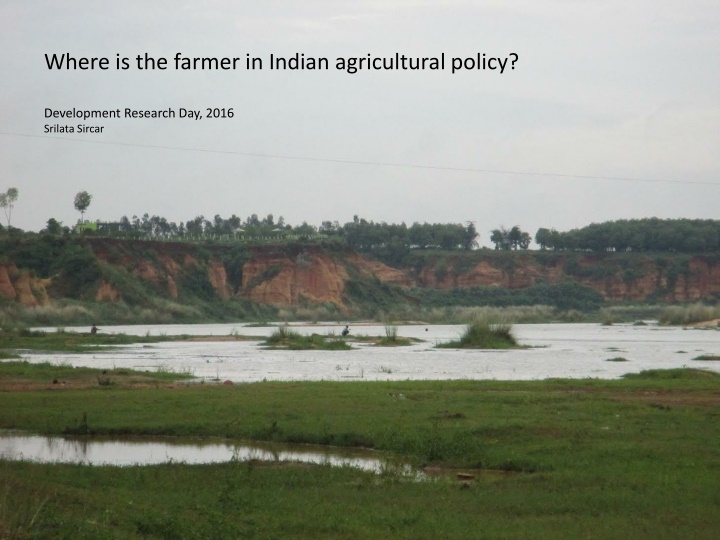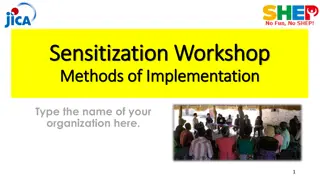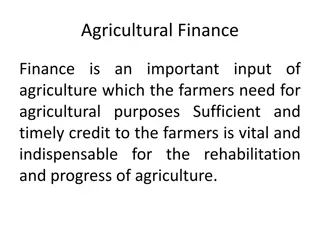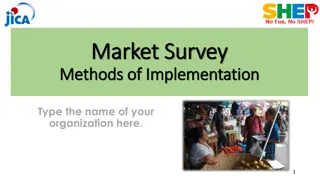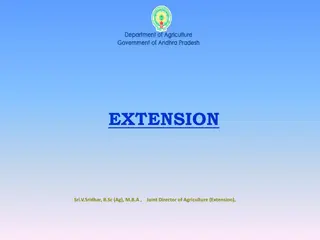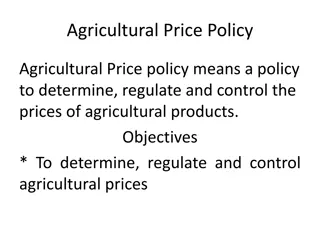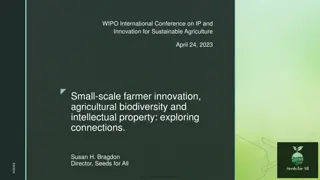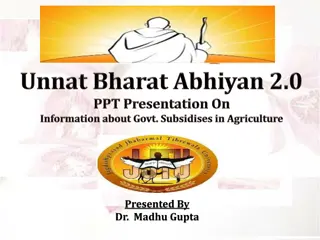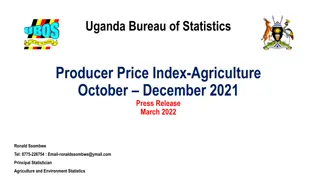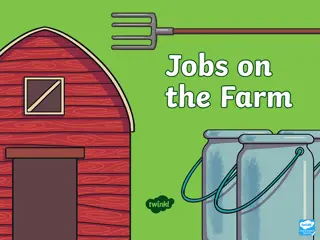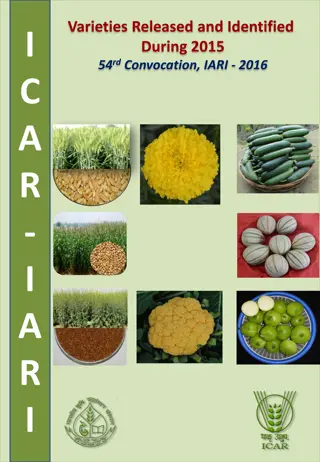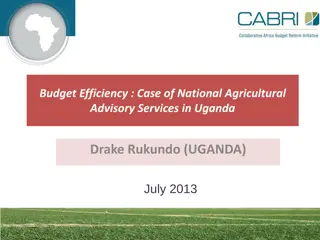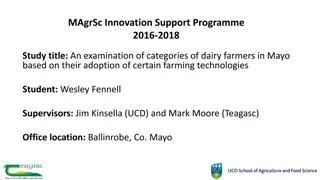The Role of Farmers in Indian Agricultural Policy Evolution
The historical evolution of Indian agricultural policies, from the 1950s to the present, reflects a shift in focus from infrastructural development to a technocratic approach. There has been a policy vacuum regarding the direct impact on farmers, with limited coverage of price support and increasing reliance on farmer investments. New policies introduced in 2000 aimed to address farmer indebtedness and distress, with a focus on growth, risk management, export orientation, and rural credit provision. The Swaminathan Committee highlighted the importance of protecting farmers' rights and ensuring food security.
Download Presentation

Please find below an Image/Link to download the presentation.
The content on the website is provided AS IS for your information and personal use only. It may not be sold, licensed, or shared on other websites without obtaining consent from the author.If you encounter any issues during the download, it is possible that the publisher has removed the file from their server.
You are allowed to download the files provided on this website for personal or commercial use, subject to the condition that they are used lawfully. All files are the property of their respective owners.
The content on the website is provided AS IS for your information and personal use only. It may not be sold, licensed, or shared on other websites without obtaining consent from the author.
E N D
Presentation Transcript
Where is the farmer in Indian agricultural policy? Development Research Day, 2016 Srilata Sircar
A Historical Overview Infrastructural and Institutional Focus o Land reforms- ceiling on holdings, formalization of tenancy contracts, redistribution o Irrigation extension (dams, canals) o Extending the area under cultivation 1. 1950s to mid-1960s
A Historical Overview Infrastructural and Institutional Focus o Land reforms- ceiling on holdings, formalization of tenancy contracts, redistribution o Irrigation extension Technocratic Focus o Agricultural research and extension o Price interventions- Food Corporation of India & Agricultural Prices Commission o Green Revolution 1. 1950s to mid-1960s 2. Late 1960s to 1980s
A Historical Overview Infrastructural and Institutional Focus o Land reforms- ceiling on holdings, formalization of tenancy contracts, redistribution o Irrigation extension Technocratic Focus o Agricultural research and extension o Price interventions- Food Corporation of India & Agricultural Prices Commission o Green Revolution Policy Vacuum/Indifference o Impact of policies from other sectors o Limited coverage of price support o Increasing reliance on investments from farmers 1. 1950s to mid-1960s 2. Late 1960s to 1980s 3. 1990s
New Agricultural Policy (2000) Introduced in response to rising farmer indebtedness, agrarian distress including farmer suicides, and widening regional disparities o o o o Focus on the key areas of : Growth (targeted 4%, actually achieved 2.3% on average through wide fluctuations) risk management (through crop insurance, meant to be provided through financial inclusion) export orientation of agricultural production (diversification and cash crops) and provision of rural credit (through financial inclusion) No concrete plan for implementation!
Swaminathan Committee on Farmers (2006) Constituted in 2004 after formation of a new government and pressure from agricultural interest groups Key recommendations: o o o o Prevent diversion of agricultural land and forests to the corporate sector for non-agricultural pruposes Complete the un-finished (un-begun?) land reforms Re-instate customary rights to common property resources for Adivasis and pastoralist communities Re-instate the universal public distribution system to ensure food security Two points of departure: the farmer is not merely a food producer but also a food consumer and therefore vulnerable to food insecurity; the farmer is not a monolithic figure
Who is the farmer in Indian agriculture?
Who is the farmer in Indian agriculture? Underlying assumptions:
Who is the farmer in Indian agriculture? Underlying assumptions: o The identity of the farmer is/can be derived from the size of landholdings
Who is the farmer in Indian agriculture? Underlying assumptions: o The identity of the farmer is/can be derived from the size of landholdings o Productivity translates into income
Who is the farmer in Indian agriculture? National Policy for Farmers (2007), Ministry of Agriculture, Govt. of India, p.2
Who is the farmer in Indian agriculture? Big(ger) landowning, pluriactive households, new forms of absenteeism Wage labor from Dalit, Adivasi, or other marginalized groups Cultivation through wage labor
Who is the farmer in Indian agriculture? Big(ger) landowning, pluriactive households, new forms of absenteeism Wage labor from Dalit, Adivasi, or other marginalized groups Cultivation through wage labor Share-cropping Informal contracts, wide varieties in contractual practices Insecurity of tenure
Who is the farmer in Indian agriculture? Big(ger) landowning, pluriactive households, new forms of absenteeism Wage labor from Dalit, Adivasi, or other marginalized groups Cultivation through wage labor Share-cropping Informal contracts, wide varieties in contractual practices Insecurity of tenure Land rented out for cash rents Usually entered into by middle-ranking, agrarian capitalist castes Not a favored option for landowning households Tenancy
Who is the farmer in Indian agriculture? Big(ger) landowning, pluriactive households, new forms of absenteeism Wage labor from Dalit, Adivasi, or other marginalized groups Cultivation through wage labor Share-cropping Informal contracts, wide varieties in contractual practices Insecurity of tenure Land rented out for cash rents Usually entered into by middle-ranking, agrarian capitalist castes Not a favored option for landowning households Tenancy Combination farming A combination of share-cropping, family labor on family farms, wage labor etc.
Where is the farmer in Indian agriculture today?
Where is the farmer in Indian agriculture today? Mr. Mevani said that Dalits in Gujarat had not restricted their struggle on the issue of cow alone. It is now converted into a movement seeking land rights. Similar struggle should be launched in Karnataka too and the government should be asked to bring out white paper on lands allotted to industries and others, http://www.thehindu.com/news/national/una-dalit- leader-jignesh-mewani-interview-material-issues- are-at-the-heart-of-dalit-politics/article9136880.ece
Where is the farmer in Indian agriculture today? According to National Sample Survey 70thround, average agricultural income per household is below 60 USD per month and income including non-agricultural sources is below 100 USD per month Of 220 million new bank accounts opened since 2014, half were found to be at zero balance and further 20 million had a balance between INR 1 and INR 10 i.e. 0.02 to 0.20 USD Average income of Dalit households in rural areas is 38% less than that of other groups and 93% Dalit families lived below the poverty line in 2012
What did we miss? Is it possible to attend to questions of agriculture and farming without attending to questions of caste?
What did we miss? Is it possible to attend to questions of agriculture and farming without attending to questions of caste? Is it possible to attend to questions of agriculture and farming without attending to questions of redistributive justice?
What did we miss? Is it possible to attend to questions of agriculture and farming without attending to questions of caste? Is it possible to attend to questions of agriculture and farming without attending to questions of redistributive justice? Is it possible to attend to questions of agriculture and farming without attending to questions of lower-level urbanization and the informal sector?
